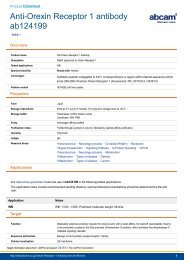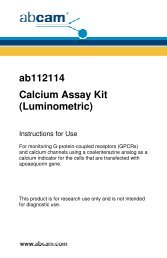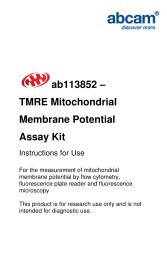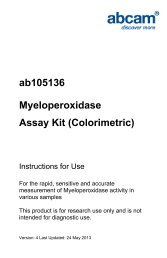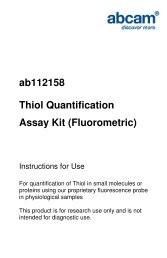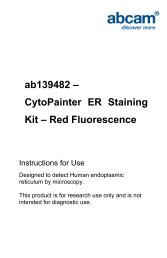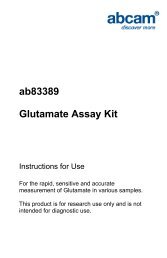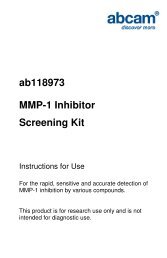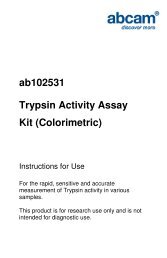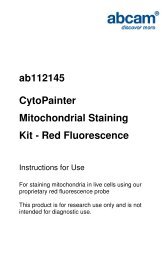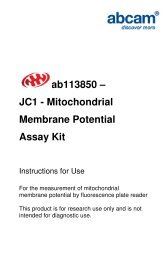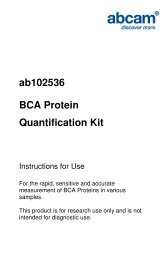ab117152 EpiSeeker Chromatin Extraction Kit - Abcam
ab117152 EpiSeeker Chromatin Extraction Kit - Abcam
ab117152 EpiSeeker Chromatin Extraction Kit - Abcam
Create successful ePaper yourself
Turn your PDF publications into a flip-book with our unique Google optimized e-Paper software.
Table of ContentsTable of Contents 21. Overview 32. Background 43. Protocol Summary 54. Components and Storage 65. Pre-Assay Preparations 86. Protocol for Cells 107. Protocol for tissues 148. Troubleshooting 179. Related Products 182
1. OverviewThe <strong>EpiSeeker</strong> <strong>Chromatin</strong> <strong>Extraction</strong> <strong>Kit</strong> contains all reagentsrequired for carrying out successful chromatin extraction directlyfrom mammalian cells or tissues. Cell membranes are broken downusing the provided lysis buffer and chromatin or DNA-proteincomplexes are then extracted with the extraction buffer. Theextracted chromatin can then be diluted with chromatin buffer andstored at the appropriate temperature.<strong>Chromatin</strong> prepared by this kit can be used in a variety of chromatinimmunoprecipitation (ChIP) methods, and it is the optimal method toprepare chromatin for <strong>Abcam</strong>’s <strong>EpiSeeker</strong> ChIP <strong>Kit</strong> – One Step(ab117138). The isolated chromatin can also be used in otherchromatin-related applications such as in vitro protein- DNA bindingassays and nuclear enzyme assays.3
2. Background<strong>Chromatin</strong> immunoprecipitation (ChIP) offers an advantageous toolfor studying protein-DNA interaction. With ChIP, researchers candetermine if a specific protein binds to the specific sequences of agene in living cells by combining with PCR (ChIP-PCR), microarray(ChIP-chip), or sequencing (ChIP-Seq) techniques. For example, themeasurement of the amount of methylated histone H3 at lysine 9 (H3methylK9) associated with a specific gene promoter region undervarious conditions can be achieved through a ChIP-PCR assay,while recruitment of H3 methylK9 to the promoters on a genomewidescale can be detected by ChIP-chip.Ab117152 addresses the inconvenience and time consuming issuesof existing chromatin preparation methods by introducing thefollowing features:Fast procedure: the entire procedure from cell/tissue sampleto ready-to-use chromatin is less than 60 minutes.Convenient and flexible: this kit is suitable for preparing bothnative chromatin and cross-linked chromatin from monolayeror suspension cells, or from tissues.Choose between sheared or un-sheared chromatin: can beused in analyses that require either intact or fragmentedchromatin, including ChIP, in vitro protein-DNA interactionanalysis, nuclear enzyme assay, etc.4
3. Protocol SummaryProtocol SummaryHarvest cell or tissue sample with or without cross-linkingLyse sample with Lysis bufferExtract chromatin with <strong>Extraction</strong> BufferSonicate isolated chromatinStore sheared chromatin5
4. Components and StorageA. <strong>Kit</strong> ComponentsItem Quantity Storage TempECE1 (10X Lysis Buffer) 11 mL RTECE2 (<strong>Extraction</strong> Buffer) 11 mL RTECE3 (<strong>Chromatin</strong> Buffer) 11 mL RTProtease Inhibitor Cocktails (1000X)* 110 µL 4 °C*Spin the solution down to the bottom prior to use.B. Additional Materials RequiredVortex mixerDounce homogenizerCentrifuges, including desktop centrifuge – keep centrifugesat 4°CPipettes and pipette tips1.5 ml microcentrifuge tubes15 ml or 50 ml conical tubesCell culture medium1X PBSDistilled water6
If cross-linking chromatin: 37% formaldehyde 1.25 M Glycine solution (previously filtered to sterilize)C. StorageStore Protease Inhibitor cocktails at 4°C.Store remaining components at room temperature.All components of the kit are stable for 6 months from the date ofshipment, when stored properly.Note: Check if any buffers contain salt precipitates before use. Ifso, shake the buffer until the salts are re-dissolved.7
5. Pre-Assay PreparationsStarting materials can include various tissue or cell samples such ascells from flask or microplate cultured cells, fresh and frozen tissues,etc.A. Starting Materials Monolayer cells: 1x10 5 – 5x10 6 cells per preparation Suspension cells: 2x10 5 – 1x10 7 cells per preparation Tissues: 10 mg – 200 mg per preparationSample type Amount <strong>Chromatin</strong> yieldCells 1 x 10 5 – 5 x 10 6 cells 4 µg/ 10 6 cellsTissue 50 – 200 mg 4 µg/ 50 mgConsiderations when preparing sample material:Frozen sample should be thawed on ice. This process could takehours depend on the amount of the pellet; keep that in mind whenthinking about experimental timings.Keep samples on ice at all times to prevent sample degradationby proteases.8
To avoid cross-contamination, carefully pipette the sample orsolution into the strip wells.Use aerosol barrier pipette tips and always change pipette tipsbetween liquid transfers.Wear gloves throughout the entire procedure.In case of contact between gloves and sample, change glovesimmediately.B. Working Buffer and Solution Preparation1. Working Lysis Buffer (1x)Prepare Working Lysis Buffer by diluting ECE1 1/10 andProtease Inhibitor Cocktail 1/1000.For instance, to prepare 10 ml Working Lysis Buffer:ECE1 (10X Lysis Buffer)1 mlProtease Inhibitor Cocktail (1000x) 10 µlddH 2 O9 ml10 ml2. Working <strong>Extraction</strong> BufferPrepare Working <strong>Extraction</strong> Buffer by adding 1 µl of ProteaseInhibitor Cocktail to every 1 ml of ECE2 (<strong>Extraction</strong> Buffer).3. 1% Formaldehyde Culture mediumAdd 270 µl of 37% formaldehyde to 10 ml culture medium.4. Ice-cold PBS: keep PBS on iceKeep all working solutions on ice.9
6. Protocol for CellsThis protocol describes how to prepare chromatin fromadherent or suspension cells, which can subsequently be usedfor <strong>Chromatin</strong> Immunoprecipitation. Instructions are given forchromatin isolation from non-cross-linked or cross-linked cells,as well as un-sheared chromatin.A. Cell Collection and Cross-linkingFor Monolayer or Adherent Cells:1. Grow cells (treated or untreated) to 80%-90% confluence on a100 mm plate (about 2x10 6 – 4x10 6 cells).2. Trypsinize cells as per your usual method and collect them into a15 ml – 50 ml conical tube. Count the cells in a hemocytometer orCoulter counter.3. Centrifuge the cells at 1000 rpm for 5 min. Discard thesupernatant.4. Wash cells with 10 ml of PBS once by centrifugation at 1000 rpmfor 5 min. Discard the supernatant. Repeat this step one moretime.Note: For cells that are not cross-linked, go directly to Step B1.10
FOR CROSS-LINKED CELLS ONLY:5. Add 10 ml of 1% formaldehyde/ culture medium solution to thepellet and resuspend by pipetting up and down carefully.6. Incubate at room temperature (20-25°C) for 10 min on a rockingplatform (50-100 rpm).7. Add 1.1 ml of 1.25 M glycine. Mix once by inversion.8. Centrifuge cells at 1000 rpm for 5 min. Discard supernatant.9. Wash cells by resuspending them in 10 ml of ice-cold PBS in a15 ml – 50 ml conical tube and centrifuge at 1000 rpm for 5 min.Carefully discard supernatant.For Suspension Cells:1. Collect cells (treated or untreated) into a 15 ml – 50 ml conicaltube. (1x 10 6 to 2x10 6 cells are required for each reaction). Countcells in a hemocytometer or Coulter counter.2. Centrifuge the cells at 1000 rpm for 5 min. Discard thesupernatant.3. Wash cells with 10 ml of PBS once by centrifugation at 1000 rpmfor 5 min. Discard the supernatant. Repeat this step one moretime.Note: For cells that are not cross-linked, go directly to Step B1.FOR CROSS-LINKED CELLS ONLY:4. Add 10 ml of 1% formaldehyde/ culture medium solution to thepellet and resuspend by pipetting up and down carefully.11
5. Incubate at room temperature (20-25°C) for 10 min on a rockingplatform (50-100 rpm).6. Add 1.1 ml of 1.25 M glycine. Mix once by inversion.7. Centrifuge cells at 1000 rpm for 5 min. Discard supernatant.8. Wash cells once by resuspending them in 10 ml of ice-cold PBSin a 15 ml – 50 ml conical tube and centrifuge at 1000 rpm for 5min. Carefully discard supernatant.B. Cell Lysis and <strong>Chromatin</strong> <strong>Extraction</strong>FOR ALL CELLS:1. Add Working Lysis Buffer to the cell pellet and resuspend bycarefully pipetting up and down:Adherent cells = 200 µl/ 1x10 6 cellsSuspension cells = 100 µl/1x10 6 cells2. Transfer cell suspension to a 1.5 ml vial and incubate on ice for10 min.3. Vortex vigorously for 10 sec and centrifuge at 5000 rpm for 5 min.4. Carefully remove supernatant from centrifuged samples. Keep asample of the supernatant for further analysis.5. Add Working <strong>Extraction</strong> Buffer to chromatin pellet and resuspendby carefully pipetting up and down (50 µl/1x10 6 cells, 500 µlmaximum for each vial).6. Incubate the sample on ice for 10 min and vortex occasionally.12
Note: if you want to use your chromatin unsheared, please proceeddirectly to step 10.7. Resuspend the sample and sonicate 2 X 20 seconds to increasechromain extraction. Allow the sample to cool on ice betweensonication pulses for 30 seconds.8. Centrifuge at 12,000 rpm at 4°C for 10 min.9. Transfer supernatant to a new vial.10.Add ECE3 (<strong>Chromatin</strong> Buffer) at a 1:1 ratio (e.g., add 100 µl ofECE3 (<strong>Chromatin</strong> Buffer) to 100 µl of supernatant).The chromatin solution can now be used immediately or stored at–80°C after aliquoting appropriately until further use. To storechromatin, snap freeze by dropping aliquots in liquid nitrogen andquickly storing tubes at –80°C freezer. Avoid multiple freeze/thawcycles.13
7. Protocol for tissuesThis protocol describes how to prepare chromatin from tissuesamples, which can subsequently be used for <strong>Chromatin</strong>Immunoprecipitation. Instructions are given for chromatinisolation from non-cross-linked or cross-linked tissues, as wellas un-sheared chromatin.A. Tissue Preparation and Cross-linking1. Put the tissue sample into a 60 – 100 mm plate. Removeunwanted tissue such as fat and necrotic material from thesample.2. Weigh the sample and cut the sample into small pieces (1-2 mm 3 )with a scalpel or scissors. Tissue should be cut in a petri dishresting on a block of dry ice to prevent sample degradation byproteases.Note: For tissues that are not cross-linked, go directly to Step B1.FOR CROSS-LINKED TISSUES ONLY:3. Transfer tissue pieces to a 15 ml – 50 ml conical tube.4. Add 1 ml of cross-link solution for every 40 mg tissues andresuspend by pipetting up and down carefully.5. Incubate at room temperature for 15-20 min on a rockingplatform.6. Add 1.1 ml of 1.25 M glycine for every 10 ml of crosslink solution.14
7. Mix once by inversion and centrifuge at 1000 rpm for 5 min.Discard the supernatant.8. Wash tissue pieces once by resuspending them in 10 ml of icecoldPBS once by centrifugation at 1000 rpm for 5 min. Discardthe supernatant.B. Cell Lysis and <strong>Chromatin</strong> <strong>Extraction</strong>1. Transfer tissue pieces to a Dounce homogenizer2. Add 1 ml Working Lysis Buffer for every 200 mg tissues (or 0.2 mlWorking Lysis Buffer for every 40 mg tissues).3. Disaggregate tissue pieces by 10 – 20 strokes.4. Transfer homogenized mixture to a 15 ml -50 ml conical tube andcentrifuge at 3000 rpm for 5 min 4°C. If total mixture volume isless than 2 ml, transfer mixture to a 2 ml vial and centrifuge at5000 rpm for 5 min at 4°C.5. Carefully remove supernatant from centrifuged samples. Keepsupernatant for analysis.6. Add Working <strong>Extraction</strong> Buffer to resuspend the chromatin pellet(50 µl/ 40 mg tissue, 500 µl maximum for each vial).7. Incubate the sample on ice for 10 min and vortex occasionally.Note: if you want to use your chromatin unsheared, please proceeddirectly to step 11.8. Resuspend the sample and sonicate 2 X 20 seconds to increasechromain extraction. Allow the sample to cool on ice betweensonication pulses for 30 seconds.15
9. Centrifuge at 12,000 rpm at 4°C for 10 min.10.Transfer supernatant to a new vial.11.Add ECE3 (<strong>Chromatin</strong> Buffer) at a 1:1 ratio (e.g., add 100 µl ofECE3 (<strong>Chromatin</strong> Buffer) to 100 µl of supernatant).The chromatin solution can now be used immediately or stored at–80°C after aliquoting appropriately until further use. To storechromatin, snap freeze by dropping aliquots in liquid nitrogen andquickly storing tubes at –80°C freezer. Avoid multiple freeze/thawcycles.Figure 1. ChIP analysis of RNA polymerase II enriched in GAPDH andMLH1 promoters using ab117138. <strong>Chromatin</strong> extract was prepared fromformaldehyde fixed colon cancer cells (2x10 5 ) using the <strong>ab117152</strong>.16
8. TroubleshootingProblem Cause SolutionLow yield ofchromatinLow yield ofchromatinDegradation ofchromatinInsufficient amountof samples.Insufficientchromatinextraction.Lysis or extractionreagents haveexpired.Incorrecttemperature and /orinsufficientincubation timeduring extraction.Improper storage ofchromatin.To obtain the best results,use 1 x10 6 - 5x10 6 cells, or50 - 200 mg tissues perChIP reaction.Ensure all reagents havebeen added at the correctvolume and in the correctorder based on the sampleamount.Check for sample lysisunder microscope after thetissue/cell lysis step.Ensure that the cell ortissue species arecompatible with thisextraction procedure.Ensure that the kit has notexceeded expiration date,as expired reagents maycause inefficient extraction.Ensure the incubation timeand temperature describedin the protocol are followedcorrectly.<strong>Chromatin</strong> sample shouldbe stored at –80°C (keepfor 3-6 months). Avoidmultiple freeze/thaw cycles.17
For further technical questions please do not hesitate tocontact us by email (technical@abcam.com) or phone (select“contact us” on www.abcam.com for the phone number foryour region).9. Related Products<strong>EpiSeeker</strong> ChIP <strong>Kit</strong> - One Step (ab117138)18
UK, EU and ROWEmail: technical@abcam.comTel: +44 (0)1223 696000www.abcam.comUS, Canada and Latin AmericaEmail: us.technical@abcam.comTel: 888-77-ABCAM (22226)www.abcam.comChina and Asia PacificEmail: hk.technical@abcam.comTel: 108008523689 ( 中 國 聯 通 )www.abcam.cnJapanEmail: technical@abcam.co.jpTel: +81-(0)3-6231-0940www.abcam.co.jp19Copyright © 2012 <strong>Abcam</strong>, All Rights Reserved. The <strong>Abcam</strong> logo is a registered trademark.All information / detail is correct at time of going to print.



